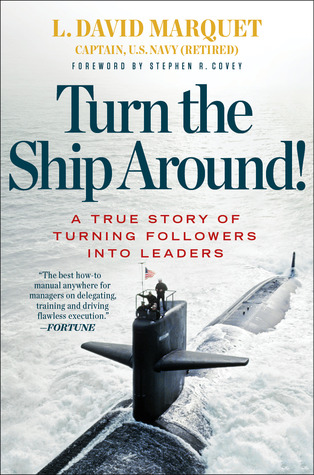More on this book
Community
Kindle Notes & Highlights
Read between
July 18 - October 31, 2022
Leadership is communicating to people their worth and potential so clearly that they are inspired to see it in themselves.
Control, we discovered, only works with a competent workforce that understands the organization’s purpose. Hence, as control is divested, both technical competence and organizational clarity need to be strengthened.
One of the things that limits our learning is our belief that we already know something.
It didn’t matter how smart my plan was if the team couldn’t execute it!
When the performance of a unit goes down after an officer leaves, it is taken as a sign that he was a good leader, not that he was ineffective in training his people properly.
ACHIEVE EXCELLENCE, DON’T JUST AVOID ERRORS is a mechanism for CLARITY.
“Don’t move information to authority, move authority to the information.”
there was the fear and cost of being different.
When you’re trying to change employees’ behaviors, you have basically two approaches to choose from: change your own thinking and hope this leads to new behavior, or change your behavior and hope this leads to new thinking.
SHORT, EARLY CONVERSATIONS is a mechanism for CONTROL. It is a mechanism for control because the conversations did not consist of me telling them what to do. They were opportunities for the crew to get early feedback on how they were tackling problems. This allowed them to retain control of the solution. These early, quick discussions also provided clarity to the crew about what we wanted to accomplish. Many lasted only thirty seconds, but they saved hours of time.
supervisors needed to recognize that the demand for perfect products the first time they see them results in significant waste and frustration throughout their organization. Even a thirty-second check early on could save your people numerous hours of work.
Is your staff spending time and money creating flawless charts and reports that are, simultaneously, irrelevant?
What happens in a top-down culture when the leader is wrong? Everyone goes over the cliff.
Here is a short list of “empowered phrases” that active doers use: I intend to . . . I plan on . . . I will . . . We will . . .
A more enlightened approach would have been to engage in a discussion about why I came up with the position and what assumptions were key to making that position work.
Even if we lost the opportunity to attack right then, I needed to get everyone on board thinking.
What was incredibly powerful was the idea that everyone was responsible for their own performance and the performance of their departments; that we weren’t going to spend a lot of effort telling them what to do.
Don’t preach and hope for ownership; implement mechanisms that actually give ownership. Eliminating the tickler did that for us. Eliminating top-down monitoring systems will do it for you. I’m not talking about eliminating data collection and measuring processes that simply report conditions without judgment. Those are important as they “make the invisible visible.” What you want to avoid are the systems whereby senior personnel are determining what junior personnel should be doing.
What is the cost of being open about problems in your organization and what are the benefits?
This was something I would wrestle with my entire command tour—balancing the courage to hold people accountable for their actions with my compassion for their honest efforts.
I’m sure he was expecting to go to captain’s mast and be fined. Yet, he was willing to tell us the truth quite bluntly without any attempt at obfuscation. This needed to be rewarded.
Specify Goals, Not Methods
We found over and over again on Santa Fe that compliance with the procedures had supplanted accomplishing the objective as the ultimate goal.
The problem with specifying the method along with the goal is one of diminished control. Provide your people with the objective and let them figure out the method.
Build Trust and Take Care of Your People
Rather than looking at the advancement process as a separate activity, we integrated it into the operations of the submarine.
Taking Care of Your People Extends Beyond Their Work Lives
The plan was approved. This was possible only because the ship had demonstrated superior skills, and through our implementation of the leader-leader structure we had developed an extensive pool of talent.
Because the crew was convinced that I was “on their team” there were never any issues with negative responses to constructive criticism. It was never a “me versus you” issue. Had they not believed I was doing everything I could for them, it would have been a lot tougher when I asked them to work so hard.
BUILDING TRUST AND TAKING CARE OF YOUR PEOPLE is a mechanism for CLARITY.
Taking care of your people does not mean protecting them from the consequences of their own behavior. That’s the path to irresponsibility. What it does mean is giving them every available tool and advantage to achieve their aims in life, beyond the specifics of the job.
Many organizations have inspiring early starts and somehow “lose their way” at some later point. I urge you to tap into the sense of purpose and urgency that developed during those early days or during some crisis. The trick is to find real ways to keep those alive as the organization grows.
Guiding principles have to accurately represent the principles of the real organization, not the imagined organization. Falseness in what the organization is about results in problems.
How can you simplify your guiding principles so that everyone in your organization understands them? How will you communicate your principles to others? Are your guiding principles referenced in evaluations and performance awards?
Use Immediate Recognition to Reinforce Desired Behaviors
Simply providing data to the teams on their relative performance results in a natural desire to improve. This has been called “gamification.”


